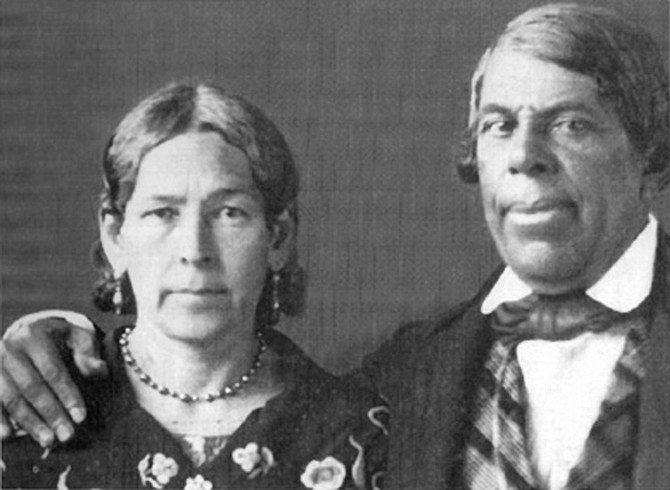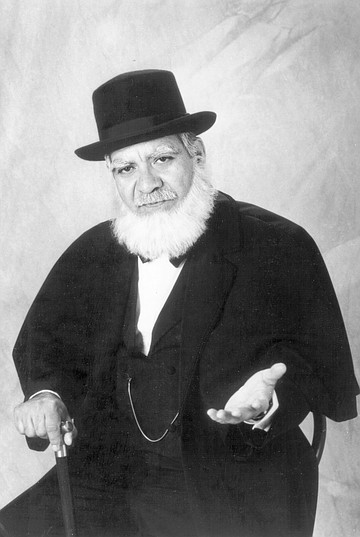 Facebook
Facebook
 X
X
 Instagram
Instagram
 TikTok
TikTok
 Youtube
Youtube

I’m surprised to meet people who have been in California all their lives and still don’t know about Pio Pico,” says Roberto Garza, who lives in Arcadia, 15 miles east of Los Angeles. “Or they know a little bit about him,” which can be worse than nothing. “A woman said to me, ‘Oh, I know about Pico. He sold all those missions.’ What a small perception.” Garza was born in Mexico, in 1949, and grew up in Texas and Illinois. But even before he moved to California, when he was in his 30s, he knew about Pico, California’s last Mexican governor.

Pico was born in 1801 in San Gabriel, where Garza teaches English to adults. Garza also works as an actor, and about ten years ago, he was asked to portray Pico for the first time. That’s when he began to research and learn in detail about the man whose name is found on boulevards, libraries, schools, and parks.
William Ellsworth Smythe, in his History of San Diego (1907), describes Pico as “a man of little education and only moderate intelligence.” Pico has been described by other historians as “an ignorant fellow who ruled by the sword.” It’s true, Garza says, that “many people didn’t think highly of him,” but often they were being “dishonest about the reality of his life.”
Pico’s father was a soldier. When he died in 1819, the family, including Pico and his nine siblings, moved from San Gabriel to San Diego’s Old Town. The house stood near the present-day Casa De Pico restaurant, says Bob Wohl, Old Town’s historic sites manager.
The young Pico was an entrepreneur, breeding cattle and selling leather hides. He also liked to gamble, a pastime that would later be his undoing.
After Mexico won its independence, not only the United States but Britain, France, and Russia hoped to annex California. Pico favored the British. He counted many Englishmen among his intimates, including his brother-in-law, John Forrester. Garza says Pico also preferred a British takeover because he thought Americans were aggressive and impatient. “He was quite dismayed about how they were transforming the land.”
“They are cultivating farms, establishing vineyards, erecting mills, sawing up lumber, building workshops, and doing a thousand other things which seem natural to them, but which Californians neglect or despise,” Pico said in a speech.
And yet Pico himself built a multi-storied hotel in Los Angeles, Pico House. Garza says it was the first with indoor plumbing.
Pico’s political career, which began in the late 1820s, was scattered and maverick. It was while he was governor, from 1845 to 1846, that he sold or leased the missions. He needed the money to run things, says Garza. It’s also true, however, that he sold the mission at San Juan Capistrano to his brother-in-law for $750. “John Forrester became quite wealthy, thanks to Pio Pico.”
During the gold rush, Pico got rich, too. He sold supplies to miners and began cattle farming again. Eventually he owned a ranch called Santa Margarita y Las Flores. It’s called Camp Pendleton today.
It wasn’t his for long. To repay gambling debts, he sought the help of Forrester. “Pico thought he was signing off on half the ranch. He couldn’t read English, though, and released the whole ranch to Forrester.” Despite a court battle, he never regained it.
“He was too generous and too trusting. People took advantage of him.” But his ways with money weren’t always wise, either, Garza concedes.
Garza sometimes portrays Pico as a man in his prime, wearing a luxurious poncho. His performance this weekend features him at age 92. “So I’ll wear makeup and turn into an old man, and my costume will be an elegant 19th-century English coat, velvet vest, and top hat, and I’ll carry a cane. I’ll also dye my hair, eyebrows, and moustache, and wear a long, long beard.”
Garza uses no script; each performance is improvised. To prepare, he says, “I will imagine Pio in the places he lived in San Diego. I will think of the time he spent at the courthouse fighting to regain the ranch; and the times he got on his horse and in one day traveled from San Diego to Los Angeles, just to bet on a horse race."
He’ll also think of “how Pio welcomed to California people from other parts of the world, and how many of them developed a liking for it, marrying daughters of Californios, accepting their ways, learning Spanish, becoming Catholic.”
Although Pico had no children by his wife, he may have had children with other women. Says Garza, “Pico has descendants who claim him.”
Pico died in 1894 and was buried in Los Angeles in what’s referred to as a pauper’s grave. In the 1920s, his body was moved to the cemetery on the grounds of the Workman-Temple Family Homestead Museum in the City of Industry, California. This was accomplished by Walter Temple, a grandson of the Workmans.
“It’s a fitting honor,” says Garza, “because when Pio Pico was governor, he granted that land to the Workman family.”


I’m surprised to meet people who have been in California all their lives and still don’t know about Pio Pico,” says Roberto Garza, who lives in Arcadia, 15 miles east of Los Angeles. “Or they know a little bit about him,” which can be worse than nothing. “A woman said to me, ‘Oh, I know about Pico. He sold all those missions.’ What a small perception.” Garza was born in Mexico, in 1949, and grew up in Texas and Illinois. But even before he moved to California, when he was in his 30s, he knew about Pico, California’s last Mexican governor.

Pico was born in 1801 in San Gabriel, where Garza teaches English to adults. Garza also works as an actor, and about ten years ago, he was asked to portray Pico for the first time. That’s when he began to research and learn in detail about the man whose name is found on boulevards, libraries, schools, and parks.
William Ellsworth Smythe, in his History of San Diego (1907), describes Pico as “a man of little education and only moderate intelligence.” Pico has been described by other historians as “an ignorant fellow who ruled by the sword.” It’s true, Garza says, that “many people didn’t think highly of him,” but often they were being “dishonest about the reality of his life.”
Pico’s father was a soldier. When he died in 1819, the family, including Pico and his nine siblings, moved from San Gabriel to San Diego’s Old Town. The house stood near the present-day Casa De Pico restaurant, says Bob Wohl, Old Town’s historic sites manager.
The young Pico was an entrepreneur, breeding cattle and selling leather hides. He also liked to gamble, a pastime that would later be his undoing.
After Mexico won its independence, not only the United States but Britain, France, and Russia hoped to annex California. Pico favored the British. He counted many Englishmen among his intimates, including his brother-in-law, John Forrester. Garza says Pico also preferred a British takeover because he thought Americans were aggressive and impatient. “He was quite dismayed about how they were transforming the land.”
“They are cultivating farms, establishing vineyards, erecting mills, sawing up lumber, building workshops, and doing a thousand other things which seem natural to them, but which Californians neglect or despise,” Pico said in a speech.
And yet Pico himself built a multi-storied hotel in Los Angeles, Pico House. Garza says it was the first with indoor plumbing.
Pico’s political career, which began in the late 1820s, was scattered and maverick. It was while he was governor, from 1845 to 1846, that he sold or leased the missions. He needed the money to run things, says Garza. It’s also true, however, that he sold the mission at San Juan Capistrano to his brother-in-law for $750. “John Forrester became quite wealthy, thanks to Pio Pico.”
During the gold rush, Pico got rich, too. He sold supplies to miners and began cattle farming again. Eventually he owned a ranch called Santa Margarita y Las Flores. It’s called Camp Pendleton today.
It wasn’t his for long. To repay gambling debts, he sought the help of Forrester. “Pico thought he was signing off on half the ranch. He couldn’t read English, though, and released the whole ranch to Forrester.” Despite a court battle, he never regained it.
“He was too generous and too trusting. People took advantage of him.” But his ways with money weren’t always wise, either, Garza concedes.
Garza sometimes portrays Pico as a man in his prime, wearing a luxurious poncho. His performance this weekend features him at age 92. “So I’ll wear makeup and turn into an old man, and my costume will be an elegant 19th-century English coat, velvet vest, and top hat, and I’ll carry a cane. I’ll also dye my hair, eyebrows, and moustache, and wear a long, long beard.”
Garza uses no script; each performance is improvised. To prepare, he says, “I will imagine Pio in the places he lived in San Diego. I will think of the time he spent at the courthouse fighting to regain the ranch; and the times he got on his horse and in one day traveled from San Diego to Los Angeles, just to bet on a horse race."
He’ll also think of “how Pio welcomed to California people from other parts of the world, and how many of them developed a liking for it, marrying daughters of Californios, accepting their ways, learning Spanish, becoming Catholic.”
Although Pico had no children by his wife, he may have had children with other women. Says Garza, “Pico has descendants who claim him.”
Pico died in 1894 and was buried in Los Angeles in what’s referred to as a pauper’s grave. In the 1920s, his body was moved to the cemetery on the grounds of the Workman-Temple Family Homestead Museum in the City of Industry, California. This was accomplished by Walter Temple, a grandson of the Workmans.
“It’s a fitting honor,” says Garza, “because when Pio Pico was governor, he granted that land to the Workman family.”